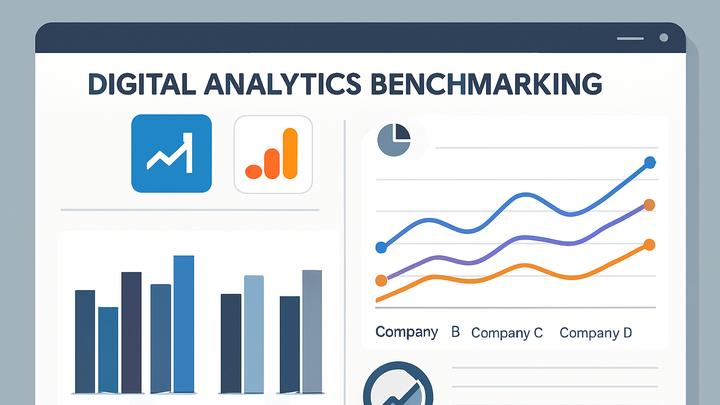Published on 2025-06-22T02:03:29Z
What is Benchmarking? Examples in Analytics
In analytics, benchmarking is the practice of measuring and comparing key performance metrics against predefined standards, whether internal, industry, or competitor-based. It provides context to your raw data by revealing where you stand relative to peers, past performance, or best-in-class. By establishing benchmarks, organizations can set realistic targets, track progress over time, and identify areas for improvement. Tools like PlainSignal (cookie-free, simple analytics) and Google Analytics 4 offer built-in benchmarking features, enabling teams to harness anonymized industry data and internal cohorts for deeper insights. Effective benchmarking drives data-driven decision-making and continuous optimization across digital channels.
Key metrics commonly benchmarked include:
- Pageviews
- Session duration
- Bounce rate
- Conversion rate
Benchmarking
Benchmarking in analytics is the process of comparing performance metrics to standards to uncover gaps and drive improvements.
What is Benchmarking?
Benchmarking involves gathering and comparing metrics such as pageviews, session duration, bounce rate, and conversion rate against reference points to gauge performance gaps and opportunities.
-
Core definition
Benchmarking in analytics means measuring your site’s or app’s metrics against internal past results, industry averages, or competitors to understand relative performance.
Why Benchmarking Matters
Benchmarking contextualizes performance data, highlights growth opportunities, and informs strategic decisions by providing a clear frame of reference. It helps teams prioritize optimizations and validate the impact of changes over time.
-
Identify growth opportunities
Comparing metrics to industry norms uncovers underperforming areas that warrant attention.
-
Measure progress over time
Internal benchmarking against historical data reveals trends and assesses the effectiveness of optimization efforts.
-
Competitive analysis
Competitor benchmarking sheds light on market positioning and highlights best practices to adopt.
Types of Benchmarking
Different benchmarking approaches cater to varied analytical needs, from comparing against your own past data to leveraging aggregated industry or best-in-class metrics.
-
Internal benchmarking
Comparing current metrics with historical data within the same organization to track progress.
-
Competitor benchmarking
Analyzing competitors’ public or estimated metrics to understand relative market position.
-
Industry benchmarking
Using aggregated, anonymized data—such as GA4’s benchmark reports—to measure against sector averages.
-
Best-in-class benchmarking
Identifying top performers, regardless of industry, to set aspirational targets and uncover innovative tactics.
Setting Up Benchmarking with PlainSignal and GA4
Implement benchmarking by properly configuring your analytics platforms. Below are step-by-step setups for PlainSignal and Google Analytics 4.
-
PlainSignal setup
PlainSignal offers a cookie-free, privacy-focused analytics solution. To enable benchmarking:
<link rel="preconnect" href="//eu.plainsignal.com/" crossorigin /> <script defer data-do="yourwebsitedomain.com" data-id="0GQV1xmtzQQ" data-api="//eu.plainsignal.com" src="//cdn.plainsignal.com/plainsignal-min.js"></script>After installation, go to the PlainSignal dashboard and enable comparative reports under the “Benchmarking” settings.
-
Install tracking snippet
Add the provided HTML snippet to every page, just before the closing </head> tag.
-
Enable benchmark reports
Activate the benchmarking feature in the PlainSignal dashboard and select metrics to compare.
-
Define reference groups
Choose traffic segments (e.g., all users or specific regions) to benchmark against.
-
-
GA4 setup
Google Analytics 4 provides built-in benchmark reporting using anonymized data from similar sites. To get started:
- Go to “Admin” > “Data Settings” > “Benchmarking Settings”.
- Enable “Share data anonymously.”
- View benchmark reports under “Reports” > “User” > “Benchmarking.”
-
Enable data sharing
Opt into anonymous data sharing to contribute to and access benchmark datasets.
-
Access benchmark reports
Navigate to the “Benchmarking” section in GA4 to compare your metrics.
-
Filter by industry
Use filters to match your site’s industry, size, and region for more relevant comparisons.
Best Practices
Adopt these best practices to make your benchmarking efforts insightful and actionable:
-
Select relevant metrics
Focus on KPIs that align with your business goals, such as conversion rate, average session duration, and bounce rate.
-
Ensure data quality
Verify tracking accuracy and consistency across platforms before running comparisons.
-
Use comparable segments
Benchmark similar traffic sources, device types, or user cohorts to ensure fair comparisons.
-
Set actionable targets
Translate benchmarking insights into SMART goals to drive continuous optimization.
